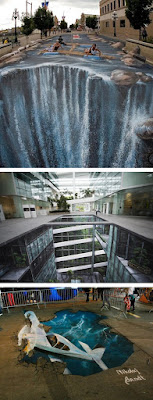I am pretty sure the temperature was above 100° F. I was creating a chalk drawing on asphalt in the northeast corner of a large parking lot. It was a clear day with a gentle breeze out of the southwest. I had to take an early break, head home, and switch into swim trunks – I was sweating that profusely.
That was the inaugural year of the West Michigan Chalk Art Festival, held during a day and a half in Byron Center, Michigan. I had never tried sidewalk art before, and hadn’t even drawn on a sidewalk as a kid. I was new to the concept, and so was the committee that dreamed up the Chalk Art Festival. Hence, I was drawing very much alone in a vast expanse of simmering blacktop.
 |
| A small sampling of sidewalk art from around the world. |
At the end of the first day, I covered up my well-developed drawing with plastic, sealed it with tape, and hoped the threat of rain wouldn’t materialize. It rained. The next morning I was eager to see the damage and make repairs before the mid-afternoon judging.
Just a small amount of rain had seeped under the tape, but it was hot enough that a greenhouse effect was generated under the plastic, creating a bigger mess from condensation.
I repaired the drawing in time for judging, and walked away with the title of Grand Prize Winner and a check for $1,000. I’ve won several times in different categories since that inaugural year, but I am still very much a novice – embarrassingly so – in a medium that, in some parts of the world, carries a monstrous WOW-factor.
Spectators don’t realize that creating sidewalk art is extremely grueling. Sure, it looks like fun. The idea of working outside and under a canopy on a nice day seems a breeze. It isn’t. Sitting on hard concrete, or squatting on it, or leaning on it for long hours takes a toll on knees and shoulders and back. The palms become sore. Fingers take the brunt of the abuse. One year, an extremely-green novice working next to me abraded off all his fingerprints, and it took a week before his hands stopped shaking and tingling. Dehydration, sunburn, and heat exhaustion can also menace the sidewalk artist who is not cautious. All this a sidewalk artist endures to create some of the most temporary art on the planet.
Yet the images can be exquisite. Mind-numbing, realistic images seemingly emerge from nowhere. One common denominator in award-winning sidewalk art is use of trompe l'oeil via a single viewpoint. This is accomplished by taking a two-dimensional image, grossly distorting it, and transferring it with a grid system to the pavement. These images make for wonderful photo-ops, but if viewers stray from the intended viewing spot, then everything goes visually haywire.
 |
| “The Ambassadors” Hans Holbein the Younger. 1533. (National Gallery, London.) |
Crowds love this sort of thing, and who can blame them? That an artist would sacrifice so much time and energy on a totally distorted, massive image for the sake of a single, fleeting viewpoint is annoyingly intriguing. But it isn’t so novel an idea.
Nearly 500 years ago Hans Holbein the Younger executed a painting of two movers and shakers of his day, “The Ambassadors.” In typical fashion, the image was replete with objects symbolizing the ambassadors’ spheres of influence and knowledge. But an odd shape stretches across the foreground. It makes no logical sense unless viewed from a specific point below the painting. Only then does an unnerving symbol of death reveal itself.
Part of the charm of sidewalk art is that, while neither carrying the esthetic heft contained in an art museum, nor signatures of Holbein or Michelangelo, it uses time-honored, enjoyable principals of fine art and exposes them to the masses. Pedestrian art may last only a day or two until the next downpour, but the wonder and memory of well-conceived pieces more than justify their worth.
 |
| “The Ambassadors” (detail) When viewed from below. |
The West Michigan Chalk Art Festival will take place June 17-18 at the Tanger Outlet Mall, U.S. 131 and 84th Street near Byron Center. The Curmudgeon will not be participating this year.
No comments:
Post a Comment